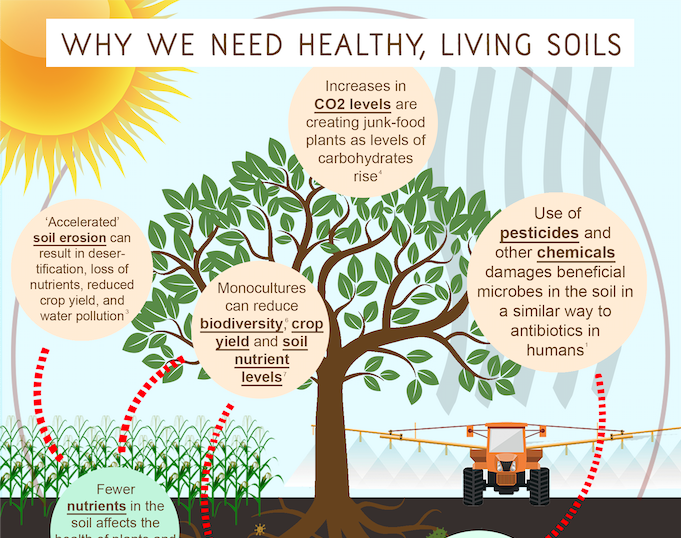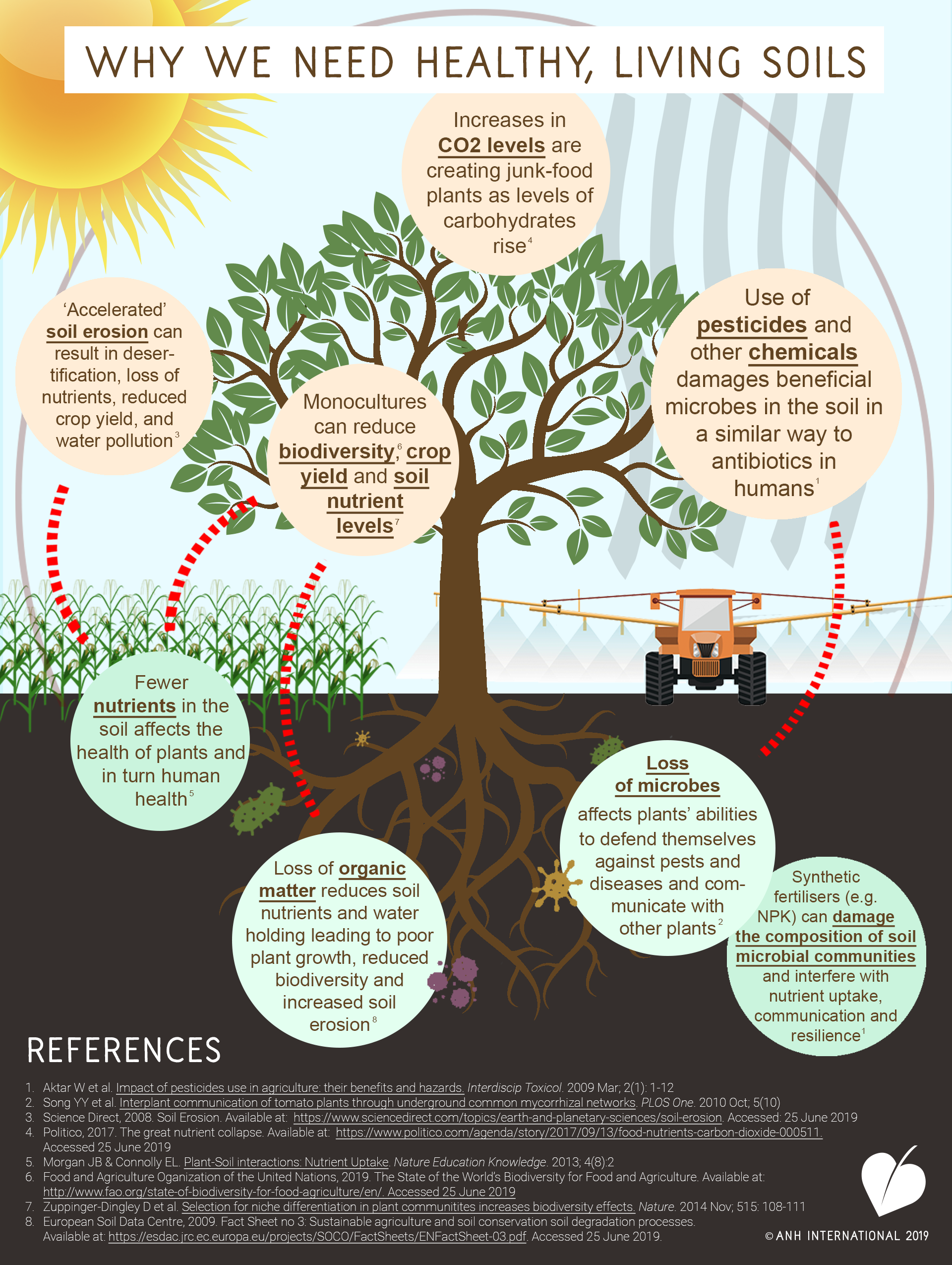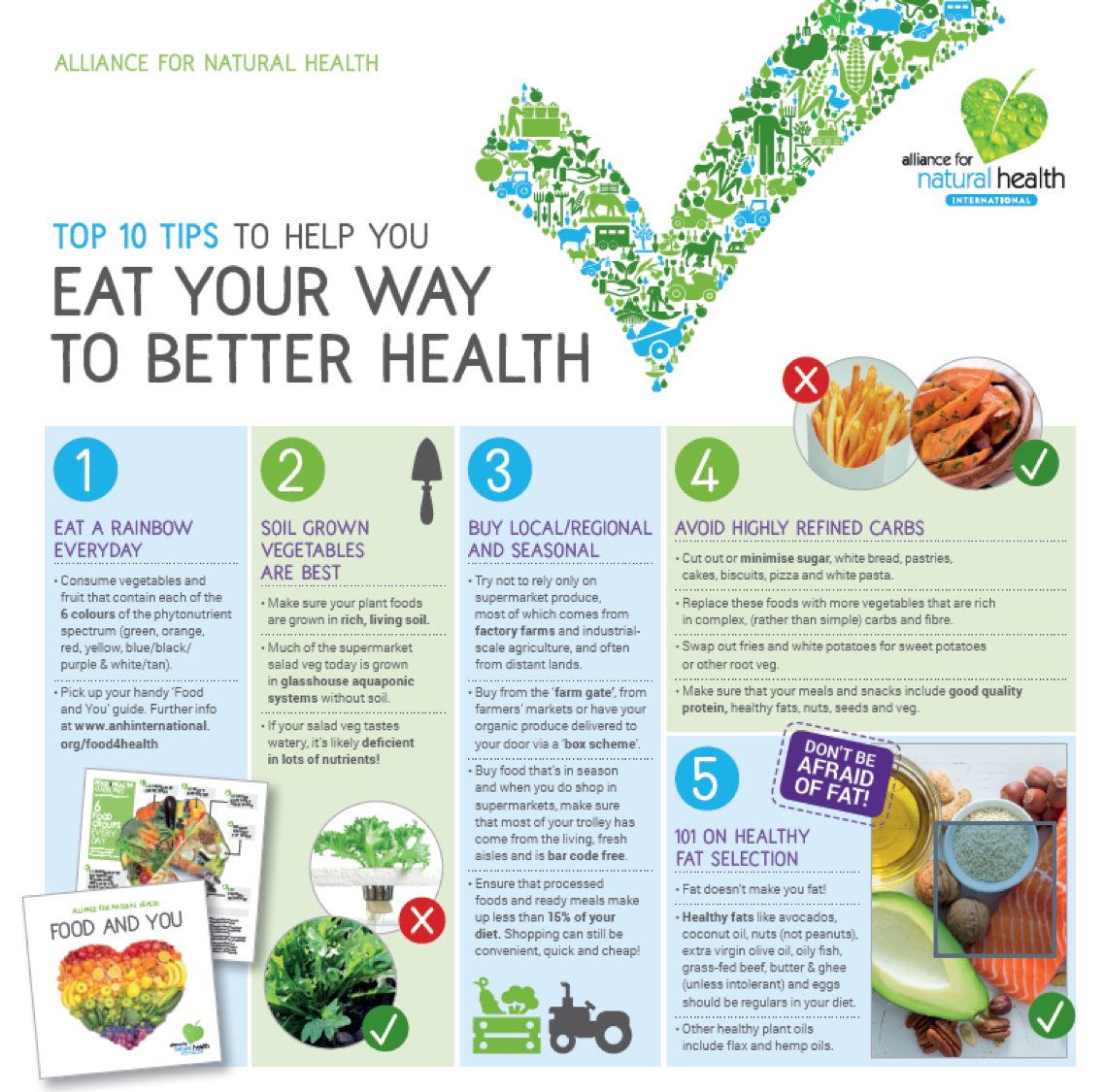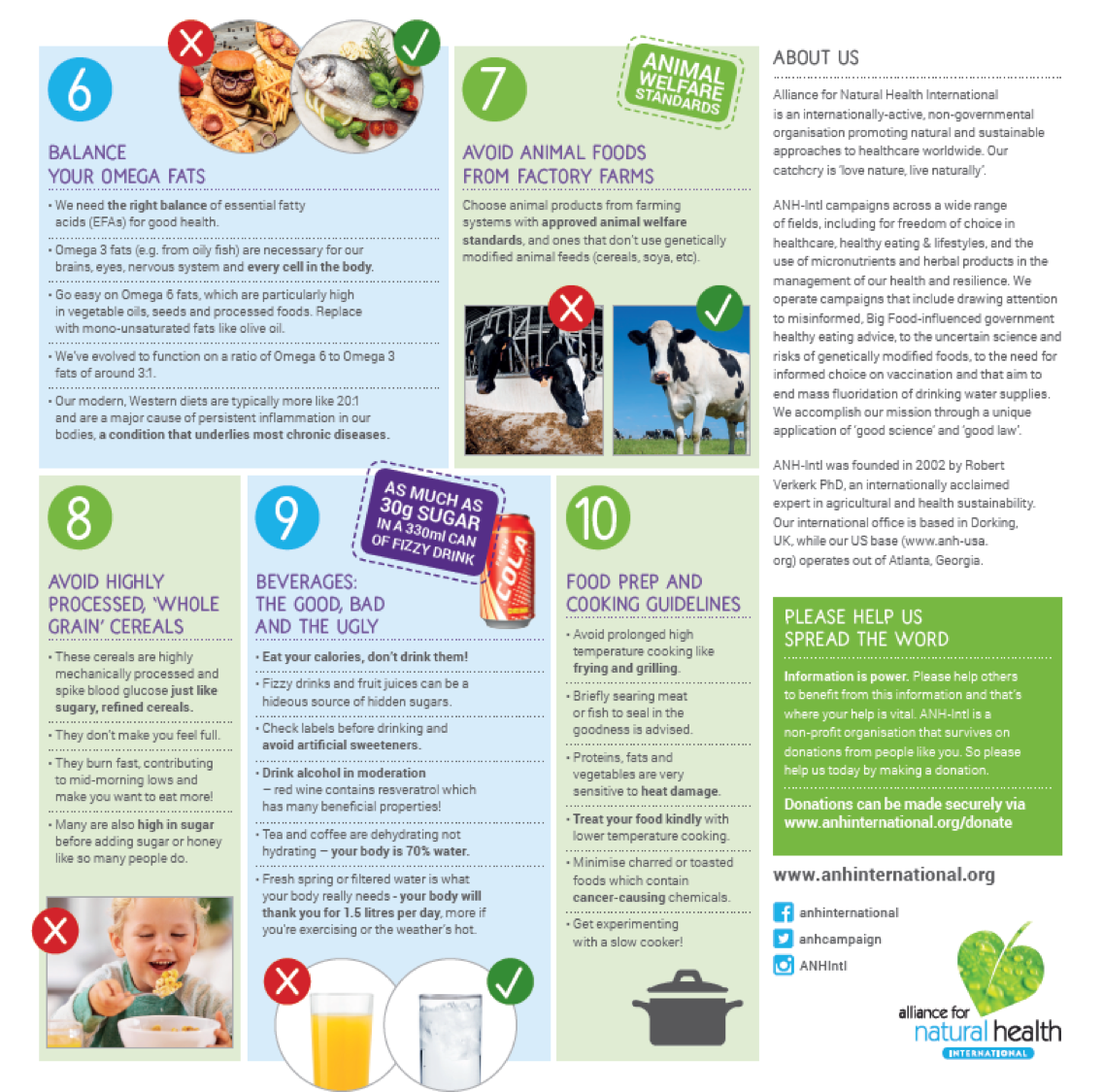Content Sections
Where does your food come from?
The public at large is getting more and more interested in the origins of its food. But if that’s just the place or country of its origin – the provenance – that doesn’t tell us very much.
When you’re dealing with any plant food, there’s one thing that’s always critical to the health of the plant – and in turn – the health of the animals, including humans, that might feed on it. That’s down to whether the plant or crop has been grown in a living soil, loaded with organic matter and microorganisms!
Soil-less cultivation vs dead soils
The hard fact is that a great deal of the plant food bought in supermarkets is grown either without soil or in soils that have been heavily degraded.
That’s a problem when there’s an abundance of evidence that shows that healthy, living soils are a prerequisite for the production of healthy foods.
The two types of plant foods that you’ll commonly find that are often grown using soil-free cultivation are:
- Soil-less cultivation: Hydroponic salad leaves (bagged salads and baby leaves) and vegetables (e.g. tomatoes, sweet peppers, cucumbers). These crops are grown in soil-less, inert media such as perlite, vermiculite, clay pebbles or rockwool and are fed a nutrient solution.
- Degraded soils: Most farmland used for monocultures and industrial-scale agriculture that include high inputs of fertilizers and pesticides. That includes the majority of the non-organic cereals, starchy and non-starchy vegetables sold in supermarkets.
The benefits of living soils
As we understand more about plants, the more we understand the importance of a living soil, rich in organic matter and teaming with microorganisms. Plants have evolved alongside these microorganisms, that are in turn dependent on the organic matter, to not only gather the nutrients they need, they also use the microorganisms (especially fungi) for communication.
Think about it. As a plant, you’re not in a position to run from your enemies, be these plant eating insects, mites or nematodes. So you need to adapt to your sessile state – and that means being able to communicate to your neighbours and friends so they can initiate some chemical warfare (using plant ‘secondary metabolites’) and a ‘cry for help’ from friends that can protect you (e.g. parasitic wasps, hoverflies, ladybird beetles).
The kinds of environment that let plants do all of this best necessitate a healthy, living soil. They also shouldn’t be over-crowded, and they need enough water and sunlight to do the magic called photosynthesis that converts sunlight energy, carbon dioxide and water into chemical energy (carbohydrate/food), oxygen and water vapour.
What’s gone wrong with the soil?
Many things have caused soil to be severely degraded since industrial agriculture kicked off in earnest after WWII.
Our graphic below tells you about some of the most important processes that are disrupted when you don’t nurture the soil in which our crops grow.
Click on image to download linked PDF
Benefits of healthy, living soils
In short, this tiny layer of decomposing organic matter that covers 37.5% of the global land area is degrading so quickly because it’s value hasn’t been sufficiently recognised. Growing our plants in inert hydroponic media or on the moon won’t solve our problems. And if we’re going be concerned about rising CO2 levels in the atmosphere, we better develop a healthy regard for protecting both soils and our oceans. Both are incredibly important carbon sinks.
The Principle of Ecology is one of the core IFOAM principles for organic agriculture, stating: “Organic Agriculture should be based on living ecological systems and cycles, work with them, emulate them and help sustain them. In the case of crops this means that production should be based on the living soil.”
Here’s 6 stand-out benefits of living soils:
-
Important carbon sink that helps mitigate rising atmospheric CO2
-
Richer in organic matter and nutrients, allows better nutrient cycling
-
Healthier for humans and animals
-
Improved water conservation and resistance to drought
-
Better crop yields
-
Improved resistance to pests and diseases
How do we restore living soils?
Regenerative agriculture is the key. Organic agriculture done properly is regenerative, but some of the Big Ag players interpret organic agriculture as a kind of ‘free-from’ agriculture system that means they simply avoid adding synthetic fertilisers and pesticides. That won’t regenerate a soil. So much more is needed, such as adding or building organic matter (e.g. mulching, composting, cover crops), crop rotation, set-asides, and avoiding exposed bare soils.
All of this goes hand in hand with agro-ecological practices that are regenerative by nature. Food crops that come out of agro-ecological systems are less likely to be found in a supermarket and more likely to be found in local farm markets, at the farm gate, or through community-supported agriculture (CSA) or box schemes.
What can you do to support living soils?
It’s tough knowing how to eat responsibly – and it not having to cost the Earth (pun intended).
To ensure both planetary and human health, you could easily create a list of 30 or more things you should be looking for in the food you source.
But let’s make it easier. There are two massively important choices you can make that we think should top any list. If all of us did just these two things – we’d witness an agricultural revolution. Not only would this transform agriculture from an unsustainable system that may not be able to feed burgeoning human populations, it would also go a long way to staving off the damage humans have wreaked on the planet.
Here they are:
- Buy plant foods that have been grown in living soils. Avoid hydroponically grown salad veg grown in inert media. If you don’t know, ask the retailer. If they don’t know, look elsewhere. In 2021, the EU will prevent ‘organic’ claims on hydroponic veg.
- Opt where possible for plants (and animals) grown in or on soils that are part of an agro-ecological production system. Consider a weekly box scheme supplying local or regionally produced foods, farmers markets or buy direct from a farm shop if one is local to you. Community farming projects are also increasingly common – here’s one that’s local to us.
Download ANH Top 10 TIPS to Help You Eat Your Way to Better Health flyer











Comments
your voice counts
27 June 2019 at 6:54 am
Here goes the alternative view.
This article is well written, beautiful graphics but wrong with so many facts, it is dangerous.
Soil - Healthy Soil is made up of organic matter, yeast, bacteria, and essential elements (about 70/80 minerals in really healthy soils).
The soil here in Cheshire is up to 30 foot deep as a result of thousands of years of deciduous trees dropping their leaves and animal droppings. The soil in the Rain Forests varies from a few inches to maybe a foot at best after many thousands of years because most of the trees are not deciduous. Rain can be a danger to all ecosystems, and it has to be just right, not too much and not too little.
So, organic matter - comes mainly from leaf mold from deciduous trees, rich in 70/80 minerals. When a plant, tree, or an elephant grows from consuming a plant growing in that soil, it is a self-sustaining ecosystem. They take minerals from the soil, but when they die, those minerals are returned directly to that same soil for the next generation of trees, plants, and animals to thrive.
Elements - The 70/80 minerals that are essential for the life of plants, animals, and trees are finite. They were placed there mostly by volcanic action or washed into valleys from the mountains via rivers and streams. These minerals only become usable by the roots plants and trees by the work of yeast and bacteria, turning them into what we know minerals salts. The roots take up the mineral salts into the plants, and these become organic minerals. When animals and humans consume these plants with 70/80 organic minerals, they grow strong and grow large depending upon how much of the plants they eat.
.
If we cut down the trees or a forest fire or some other disaster takes them down the trees and soil may never recover. The soil will quickly erode from rain. The minerals salts will be washed to streams and river and to the sea.
.
Humans see this as an opportunity and start planting crops. The problem with this is the crops (or animal farming) contain the finite minerals and since they are taken away many miles to be consumed the self-sustaining ecosystem breaks down. The 70/80 minerals start to disappear, and an example is the critical minerals magnesium. Magnesium has reduced by 60% in food in the last 50% years. There are many more minerals such as selenium that we cannot be healthy without consuming them that have all but disappeared. Yes, we can supplement these minerals, and I make my living with this, but that does not solve problems of trees, plant life and nature being seriously mineral deficient.
Animal, grain, and cereal farming are unsustainable since it strips the land of nutrition and allows rain to wash away the last remaining minerals.
.
The solution? Research on intensive farming for essential foods/vegetables using seaweed rich in 70.80 minerals (all of the minerals end up in the seas). Look more closely at soilless cultivation using seaweed fertilizer and have a proper scientific evaluation of its nutritional value rather than calling it names.
.
Plant 3 trillion deciduous trees on the land previously used for the animal, grain, and cereal growing to include food-bearing trees such as fruit and nuts.
.
Co2 - Is essential for two reasons. Wildlife all over the planet is seriously at risk from the lack of oxygen. Frogs are 'the canary in the mine' and are dying all over the planet. Soon other species will start to go, and acceleration will become apparent. Oxygen is the critical element for health and life, being the power source for ATP, and our Immune system.
.
By planting 3 trillion oxygen producing deciduous trees, all over the planet, this will safeguard human health, all animal health, and re-establish proper levels of Co2 for a truly self-sustaining ecological system.
.
Our Children and Grandchildren's future may depend upon this.
27 June 2019 at 1:00 pm
Hi Robert. Love your commentary - and don't find it contradicts many of the facts made in our article - it primarily adds more fodder and proposes an alternate solution. Fully agree with tree planting, and all work on agro-ecological farming systems supports diversification of both agricultural and neighbouring natural or semi-natural habitats, with tree and hedgerow planting being right up there. You've said swap out the arable farms for silviculture - that is agro-ecological farming in action. Making it happen in the next 5 years isn't likely - over the next 30 it might be possible. Out article was about giving people something they can implement today or tomorrow - not in 3 decades time. We've referred to nutrient cycling as a general and important principle, you've given one example of it taken from natural forestry. Finally, we think it's important to recognise that the science in all of these areas is inevitably complex as it incorporates scientific studies that reveal an incomplete understanding of the function of natural and semi-natural ecosystems impacted by humans and environments that are changing at incredibly rapid rates in evolutionary terms largely as a result of human interference. We therefore need to be careful about assuming that one fix (e.g. planting 3 trillion trees) will resolve so many problems. That doesn't mean we shouldn't aspire to unprecedented levels of tree planting - but such reforestation needs to be very carefully considered to ensure it is adapted to the region in question. Oil palm in SE Asia (introduced from W Africa in the mid-1800s) is one example of reforestation with a food-bearing tree that didn't take into account agro-ecological principles. The solutions are in our view both more complex and complicated than you suggest, and nothing you've said in our view contradicts the essential tenets of our piece that proposes we promote the consumption of foods derived from healthy living soils and agro-ecological farming systems. We might just need to agree to differ on elements of detail, and we agree that in a topic as big as this there's going to be huge amounts that don't get discussed.
27 June 2019 at 12:22 pm
Good comment above - hearkens to my reading of Victor Schauberger - but the demonisation of CO2 is a signature of corporate deceit - as was butter, sat fats &etc. It works by guilt and fear to undermine Life.
Oxygen and CO2 play reciprocal and complimentary parts of a cycle at our cellular level - even as do plants and animals.
There is nothing 'junk' in food plants that grow in CO2 rich environments as a result of that factor. More likely the revers is true.
NASA report the greening of the Planet as a result of (what I see as a restoring of) CO2 levels.
Humans are being induced to retard, deny and destroy themselves in the name of a seeming crusade to 'save ourselves' but it delivers us unto a global technocratic energy (and thought) control that would be unimaginable without the Internment of Things (IoT),
There is a self-destructive agenda that runs beneath surface reality - in our mind as in our world (collective mind).
Core definitions and beliefs are unmindfully lived FROM by those who know not what they do.
But if you are not 'conforming and compliant' with the official narrative then you are 'voiceless' in the official sector - but ANH - they are denying you a voice ANYWAY!
Healed minds can discern the ways by which to stop toxifying or desecrating and degrading our Living World (and relational being) so as to serve the healing that Life of Itself embodies as the gift of wholeness. Unhealed minds seek to play out fantasy upon the body of others and world so as to 'become' worthy, powerful, successful or whatever forms of fulfilment speak to the unhealed sense of self-conflicted lack that drives and demands unconsciousness as 'narrative controls' set over unrecognized psychic-emotional conflict.
Nothing real or true can be 'afforded' by a system that is based on scarcity as a weapon of control, capture and dominion. It is 'too big to fail'. Some FORMS of new insight will be adopted but always to weaponise and marketise an existing power base.
Loving Life, each other and world is not a system - but a willingness for intimacy - which is no private fantasy gratification set in image and form - but the very power that sustains Life - because even a denial culture depends completely on what it denies as a means of seeming to live apart and over it.
As far as my research goes - CO2 is a red herring - as is the presentation of polarised competition by members of the same club.
The real toxicities of mind, feeling and physical expression are given cover so as to sustain a global death wish - that still sees itself as moving to victory. Simply the way seemingly scientific outputs are USED tells everyone that it is coercive power at work and that it is therefore in their interest to align in its assertions and demands - or 'incentives'.
But that the birds are singing now - there is no other guarantee, that singing will, ever be.
the call to joy is NOT the call to fear, division, projected guilt and hate or war. But the wish to be righteous or feel less bad about ourself drives in place of a true and free willingness. Allowing fear and guilt to frame our thinking and emotional response is succumbing TO evil in the displaced fantasy of a crusade against it as a masked or hidden hate - justified and vindicated at last!
Trees are part of providing needful cover and drawing and holding rain in the soil - but if a canopy denies life to all that is beneath - then it calls the fungus, parasite or forest fire as a way of yielding to a greater wholeness.
The arrogance is not really hidden. Our thinking is to lord it over and abuse or exploit for private or personal agenda and when the consequence of that cannot be ignored, operate the same mindset as if to manage the conflict sickness or war. the mindset is the 'sickness' from which hateful consequence comes back as valid feedback (symptoms) that are then marketised and weaponised to the sustainability of the 'mindset'.
27 June 2019 at 1:14 pm
Hi Brian - as in my comment to Robert, I agree with a lot of what you say. For example, I 100% agree the way in which big corporates and governments are handling the response to CO2 and GHGs is more down to how they can capitalise further from it, than trying to resolve the underlying problems that are as much related to habitat destruction and over-population by a single species, Homo sapiens. To deny there is an environmental crisis that is unprecedented since the Industrial Revolution that is caused largely by humans would be an odd position to take in my view, given our interpretation of available environmental science and ecological systems. Blaming all of the problems on excess atmospheric carbon and oceanic acidity (and hence an inability to buffer CO2) would be equally odd. Creating more balanced. agro-ecosystems, diversifying the vast land area that is currently used for agriculture, reinstating life to soils - and the other things we discussed in our article, still in our view remain accessible and realistic solutions to transitioning towards more stable ecological balance on our planet. You can find out more about our position on this In our report that was critical of both the nutritional and agricultural elements of the EAT-Lancet report released in January: https://www.anhinternational.org/news/anh-intl-special-report-analysis-of-the-eat-lancet-report/
28 June 2019 at 5:22 pm
Robert,
When you say reinstating life to soils I presume you mean organic matter, yeast, and bacteria. The problem is you cannot reinstate the critical minerals that have been harvested or washed to the rivers and seas. All life and health depended upon the full spectrum of minerals and it is impossible to restore them. Yes, some farmers are spreading seaweed and others are feeding to animals but this resource is so precious it has to be reserved for humans. Only intensive horticulture and soilless cultivation can produce minerals rich foods that the mass of the population need. Our only chance to restore the ecology is to plant the 3 trillion trees cut down over the past 10,000 years and hope they will survive the lack of minerals. We don't have an excess of CO2, we have a lack of trees to convert it back to oxygen.PS The environmental problem has been coming to a head for 10,000 years. Even in this short period mankind has been nearly wiped out all over the planet a few times and only survived because there was still forest areas to move to. I think we are running out of time for a real solution. Taking every car of the planet will make us healthier because we are walking more but it will not bring back minerals.
Now is the time to risk going against the mob.
Your voice counts
We welcome your comments and are very interested in your point of view, but we ask that you keep them relevant to the article, that they be civil and without commercial links. All comments are moderated prior to being published. We reserve the right to edit or not publish comments that we consider abusive or offensive.
There is extra content here from a third party provider. You will be unable to see this content unless you agree to allow Content Cookies. Cookie Preferences